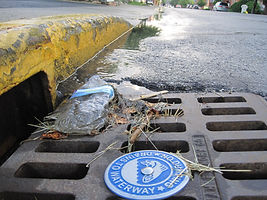
For Businesses
Businesses, institutions, churches and medical facilities all play a role in protecting our local waterways. Check out these housekeeping tips for ways to reduce your contribution to stormwater pollution. You can also contact the GLRC to partner in educating your staff and customers on pollution prevention.
The Different types of sewers
It's easy to get confused.
Did you know that communities typically have two sewer systems? A storm and a sanitary sewer.
Storm sewers redirect runoff formed during rain or snow events into a system of catch basins and pipes.
Sanitary sewers collect the wastewater from toilets and taps. This water is sent to a treatment plant to be cleaned.
However, some communities have combined systems. These combined Sewer Overflows, or CSOs, are older systems but still remain in use in some areas. This "one pipe system" combines both surface runoff (stormwater) with wastewater (sewage) and leads to a treatment plant for processing. However, these systems were designed to overflow when a heavy rain or snow melt event backlogged the system. When this occurs, the mixture of stormwater and raw sewage would flow directly into a river, stream or lake.
Untreated sewage entering our surface water had obvious impacts to the water quality and ecosystems that depend on these habitats.
To combat this, modern storm sewers have moved away from the "one pipe system" of the past and separate wastewater from storm runoff. Most of the storm sewers in the Greater Lansing area are what we call Municipal Separate Storm Sewer Systems (MS4s). Here, the sanitary sewer still directs sewage to the treatment facility, but stormwater is diverted directly to water bodies.
The MS4 system reduces the risk of large quantities of sewage entering the surface water, but since stormwater doesn't go to the treatment plant, it has it's own risks and must be "treated" in other ways. As illustrated in the graphic to the right, MS4s rely on catch basins and built infrastructure to filter out large pieces of litter, sediment, and oils, but these systems only work if they are cleaned, maintained, and understood by the public. If you see someone pouring anything down a storm drain, report it! Also report clogged or dirty catch basins to your municipality.

COMBINED SEWER OVERFLOW or ONE PIPE SYSTEM

DIAGRAM OF AN MS4

A TYPICAL CATCH BASIN


